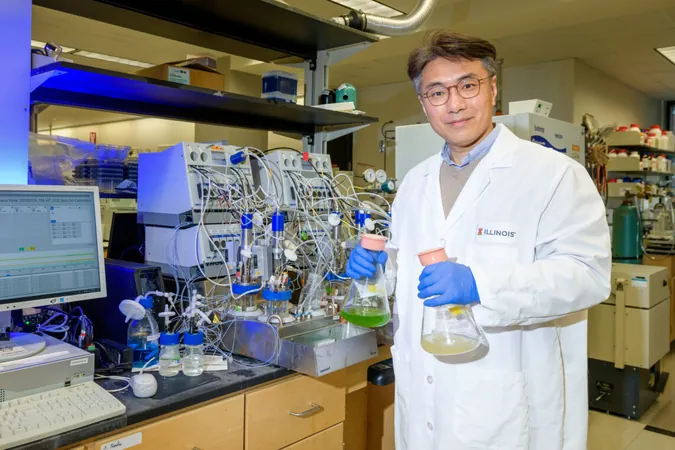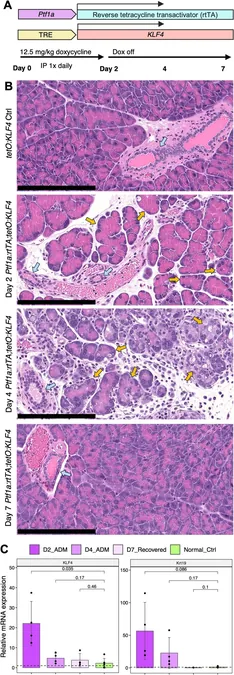
Breakthrough Research: Microalgae and E. Coli Join Forces to Transform CO2 into Valuable Resources!
2025-04-01
Author: Wei Ling
Introduction
In a groundbreaking study from the University of Illinois Urbana-Champaign, scientists are turning the tables on carbon emissions by leveraging a novel synergy between microalgae and bacteria to convert CO2 into useful products. Unlike traditional methods that depend heavily on additional carbon sources, this innovative approach harnesses the photosynthetic capabilities of a modified single-celled algae known as Chlamydomonas reinhardtii, in collaboration with the well-known bacterium Escherichia coli.
The Novel Process
In a report published in the journal *Metabolic Engineering*, research lead Yong-Su Jin highlights that while previous studies have experimented with cyanobacteria to produce sugars that serve as fuel sources, the mutant algae used in this study performs a different function. It absorbs carbon dioxide and excretes glycolate, an organic acid that E. coli can efficiently consume—something many other organisms struggle to do. This key distinction paves the way for minimizing impurities and contamination, as compared to using sugars which can attract various external organisms.
Enhanced Efficiency
“The collaboration between these organisms enhances efficiency,” Jin explained, stating that utilizing glycolate not only streamlines the process but also reduces the risk of contamination. “While sugars are beneficial for overall production, glycolate’s specificity offers unique advantages,” he added.
Preventing Self-Poisoning
One remarkable aspect of the study is how it ingeniously prevents the self-poisoning of C. reinhardtii due to excessive glycolate production. When co-cultured with E. coli, the bacteria keep glycolate levels in check, allowing the microalgae to thrive in a balanced ecosystem.
Modular Co-Culture Bioreactor
Through extensive experimentation, the researchers devised a modular co-culture bioreactor. Initially, the microalgae flourish in a controlled environment to build a dense population while managing glycolate output. Subsequently, both organisms are cultivated together, permitting the microalgae to yield enough glycolate to sustain the bacteria while generating valuable chemicals.
Successful Applications
The duo demonstrated their success by producing lycopene, a potent carotenoid antioxidant known for its various health benefits, alongside green fluorescent protein, a staple in biochemical research. Jin is optimistic about expanding these applications, envisioning the potential production of vital proteins such as insulin.
Challenges for Mass Production
However, while this method shows promise for high-value products, Jin cautions that it may not be suitable for mass production or cheaper biofuels due to the complexities and costs associated with maintaining appropriate environmental conditions within a bioreactor.
Potential for Space Travel
An exciting potential application of this technology also lies in the realm of space travel. With astronauts requiring sustainable sources for nutrients and medicines during prolonged missions, this bioconversion process is a beacon of hope, ensuring that as long as sunlight and CO2 are available, they can produce what they need on their journeys.
Conclusion
This remarkable study exemplifies the moving frontier of biotechnology, illustrating how blending nature with scientific innovation may hold the key to combating climate change and addressing future resource challenges. Will this groundbreaking research lead humanity toward sustainable practices that can transform our ecosystems? Only time will tell!



 Brasil (PT)
Brasil (PT)
 Canada (EN)
Canada (EN)
 Chile (ES)
Chile (ES)
 Česko (CS)
Česko (CS)
 대한민국 (KO)
대한민국 (KO)
 España (ES)
España (ES)
 France (FR)
France (FR)
 Hong Kong (EN)
Hong Kong (EN)
 Italia (IT)
Italia (IT)
 日本 (JA)
日本 (JA)
 Magyarország (HU)
Magyarország (HU)
 Norge (NO)
Norge (NO)
 Polska (PL)
Polska (PL)
 Schweiz (DE)
Schweiz (DE)
 Singapore (EN)
Singapore (EN)
 Sverige (SV)
Sverige (SV)
 Suomi (FI)
Suomi (FI)
 Türkiye (TR)
Türkiye (TR)
 الإمارات العربية المتحدة (AR)
الإمارات العربية المتحدة (AR)